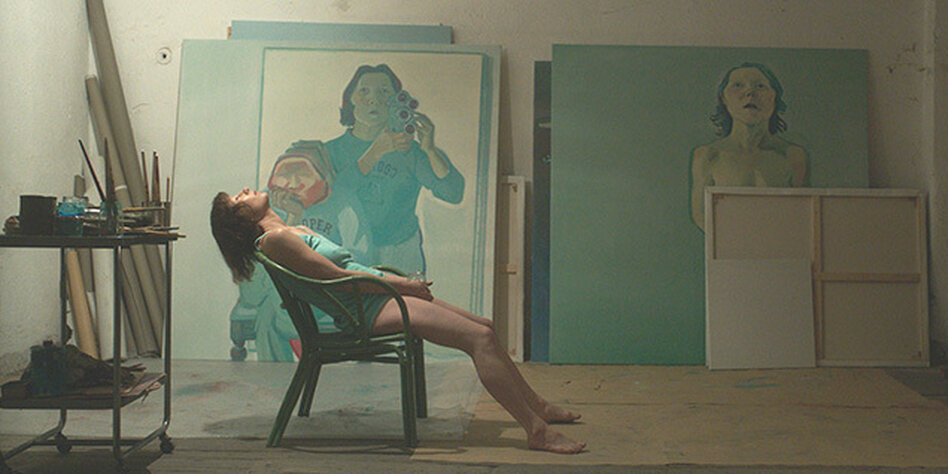In ‘Sleeping with a Tiger’, director Anja Salomonowitz shows the painter Maria Lassnig as a fragile character, played by Birgit Minichmayr.
Birgit Minichmayr as Maria Lassnig in ‘Sleeping with a Tiger’ Photo: Arsenal Film Distribution
Oh, she was fickle. As soon as she walks through an exhibition of her photos and scolds the curator and the entire team when they couldn’t see that it wasn’t possible, the light was too yellow and the photos too deep. Yes, those who did that probably didn’t understand their art. Other times, however, she is extremely satisfied with the way her works are displayed. She is quite old, her back is crooked, her glasses are thick. Could she give an interview now? Maria Lassnig refuses this and says more to herself: now she is happy. She only gives interviews when she’s depressed, that’s more her life.
Birgit Minichmayr plays the Austrian painter Maria Lassnig with a touch of silent self-irony in the film ‘Sleeping with a Tiger’ by Anja Salomonowitz, who wrote and directed the script. At one point, Minichmayr lies on a couch under a blanket, only his face looking out, his anxious eyes focused on his mother, who is sitting on the edge. You are now packing your suitcase and looking for a new mother, that’s pretty much what the mother (Johanna Orsini) says. Sometimes when the painter looks in the mirror, the mother, who has already died, appears behind her. Sometimes her portrait is faintly visible behind a self-portrait of the painter.
The scenes in which Anja Salomonowitz tells about Maria Lassnig are often constructed close to the paintings shown repeatedly. The film title also comes from a famous photo of Lassnig.
Birgit Minichmayr plays Maria Lassnig as a child, as an old woman, as an art student, as a lonely warrior in Paris, as a lonely person in New York. The flow of time is undermined, memories are as present as the present.
The artist as an antisocial being
The film paints the picture of an artist as an antisocial being. The photos are her children, she has less contact with people. A woman has to work three times as hard as a man just because she is a woman, she once told a lover and younger artist friend who will soon overtake her in career. The film has a lot to say about the pain of being misunderstood and ignored. And also about the aging artist’s distrust that the collectors, whose interest in her was so insultingly late, now want to steal from her.
The film does not necessarily portray the protagonist as sympathetic, but gradually makes her understand her quirks and eccentricities.
Maria Lassnig, born in 1919 in rural Carinthia, died in 2014 at the age of 94, had to wait a long time for recognition and success. The film also emphasizes this, but mainly focuses on scenes with her alone in the studio, her exploration of translating sensations, feelings, physical states into colors, giving an image of the inside of the body. Could you see pain if you cut open the body? With this question she scares a child who just wanted to take her a towel to the bathtub.
Costume designer Tanja Hausner wraps the painter’s figure in somewhat obscure sweaters and tracksuits that don’t exactly conform to the usual patterns of beauty and elegance, but instead play wildly with the colors she brought to the canvas. Many shots are long and static. The director does not tell the story chronologically, but links recurring motifs, such as the ambivalent relationship with her mother and her power or the experience of marginalization as an artist.
No tendency towards transfiguration
At times the director manages to capture the mischief and humor that Lassnig certainly shows in her photographs. The young painter is alone with her work in front of an exhibition that has abruptly closed, her friends are driving away and she doesn’t know how to carry it all. Ants come to her rescue and carry a picture.
Biopics about female artists often tend to glorify them, to create heroines that you need now as role models. Anja Salomonowitz does not take this seductive turn. But in the fragility of her cinematic story, in the closeness she maintains to the protagonist, to her perceptions, to her efforts, she also closely draws the imaginary space. You will need some patience to follow the somewhat strenuous film over its entire length. But if you’re excited about Maria Lassnig or Birgit Minichmayr or even both Austrians, you’ll probably take them with you.


